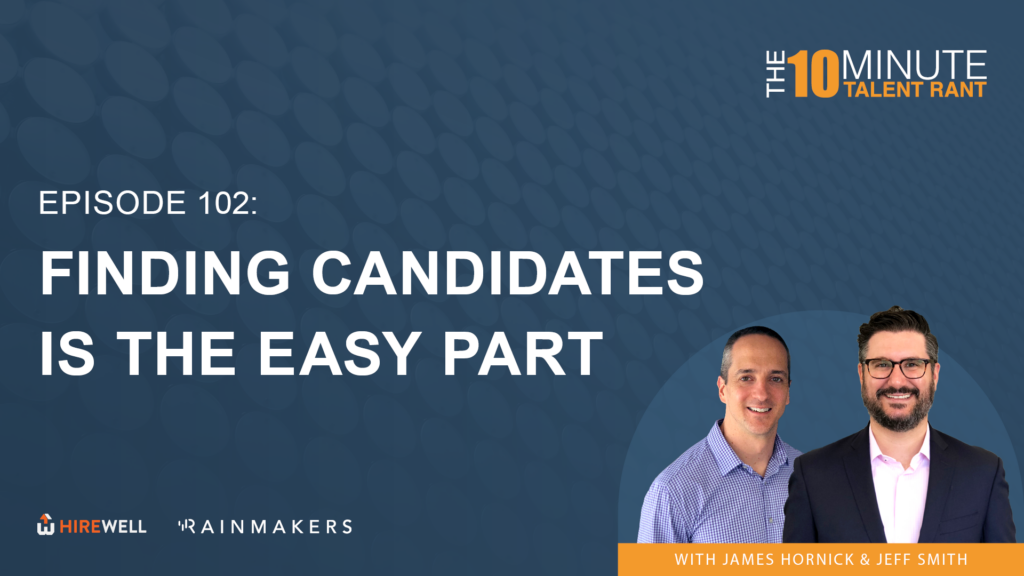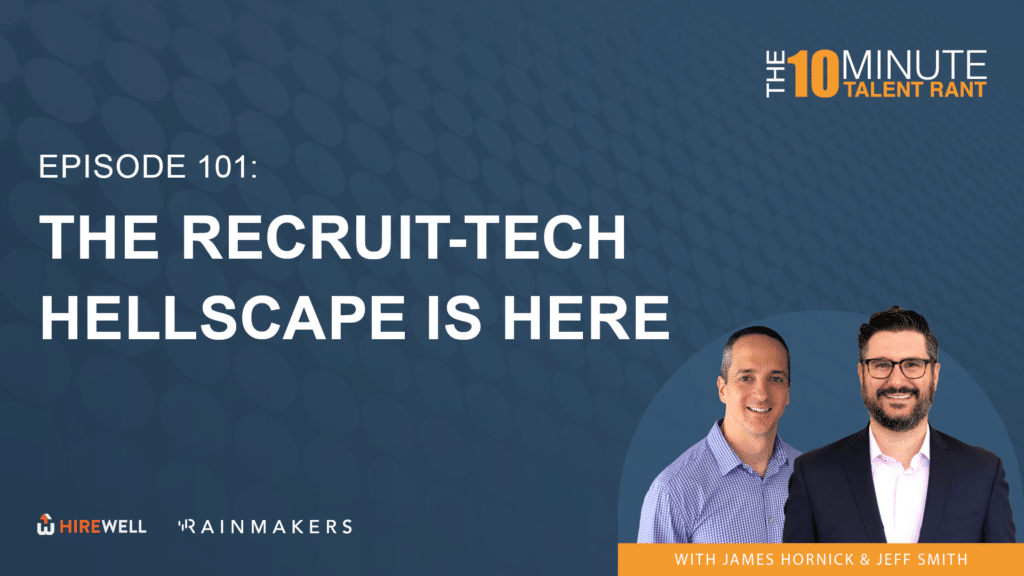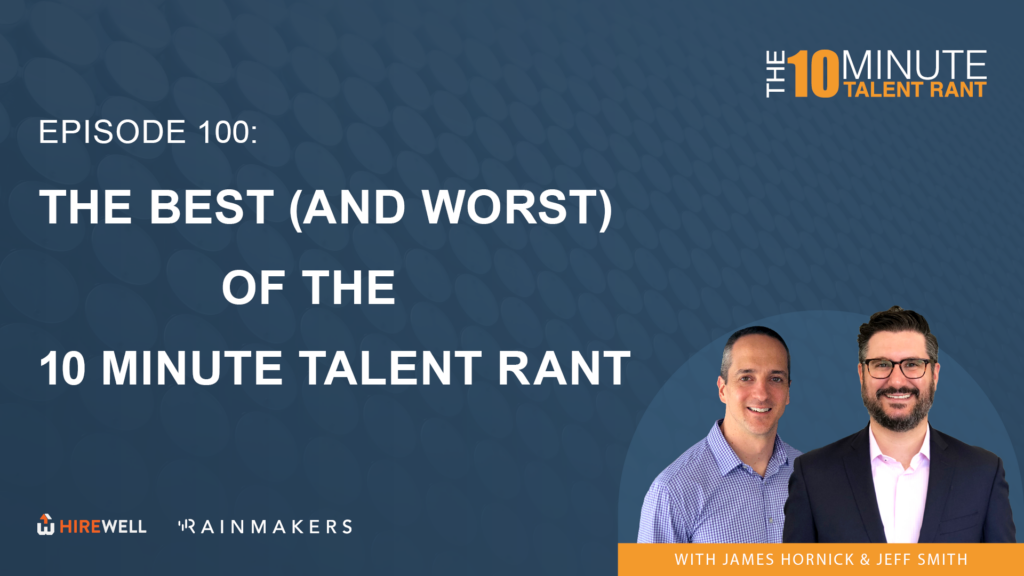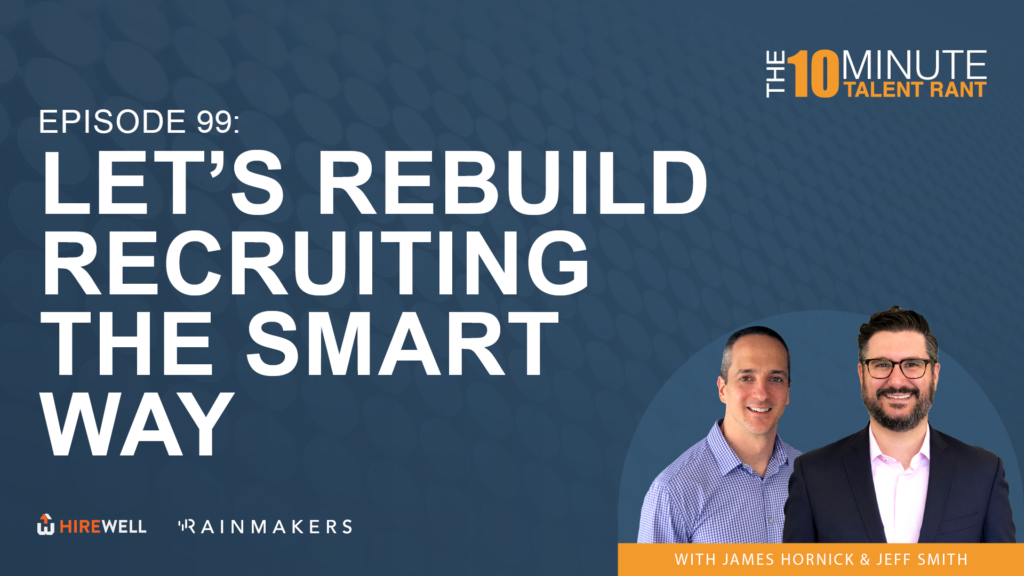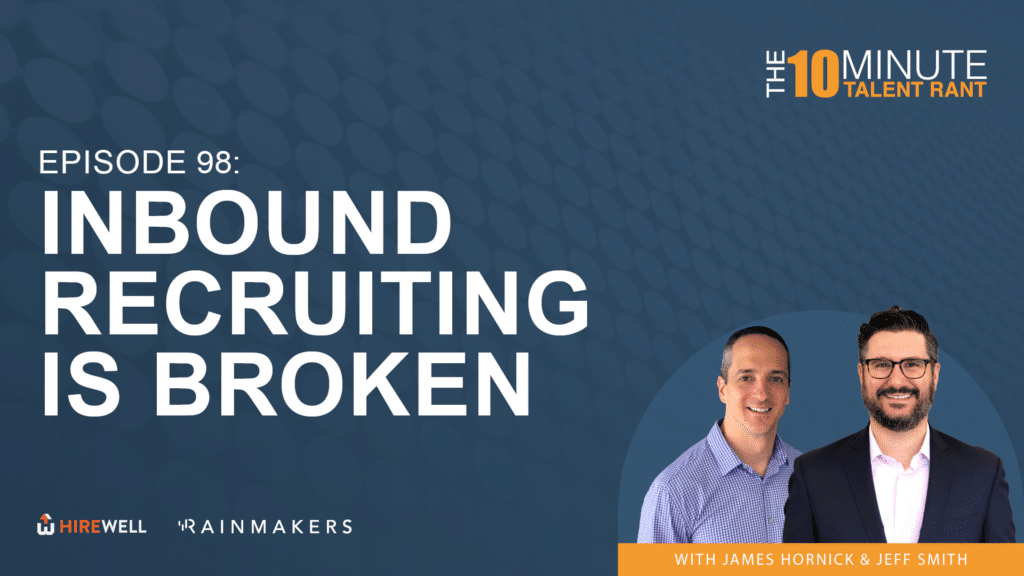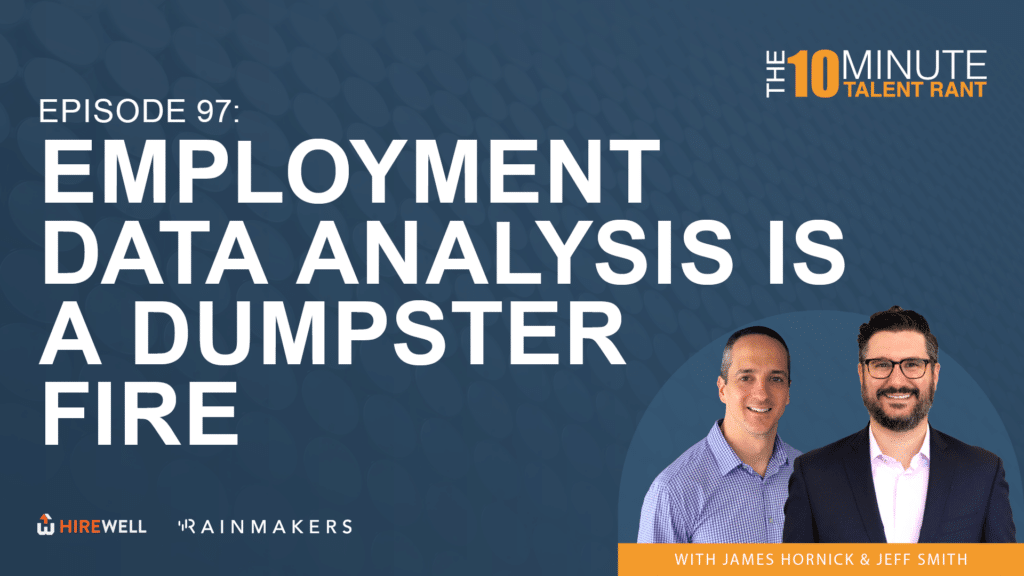The 10 Minute Talent Rant is live. I’m James Hornick joined by Jeff Smith and we are on the clock. The 10 Minute Talent Rant is our ongoing series where we break down things that are broken in the talent acquisition and hiring space, maybe even pitch a solution or two. Before we dig in, all of our content can be found on talentinsights.hirewell.com.
This week’s topic, are you ready, Jeff? Episode 85, Will LinkedIn Be Dead in 10 Years? Posting about a platform’s demise on said platform. Yes. Very meta. This has been another exciting edition of posting about posting. Before you think it’s an alarmist title, it’s really not. I mean, every social platform, every online service, there’s a natural observable rated decay. Facebook’s gone, like Google search isn’t what it used to be. Twitter’s turned into a cesspool, even apps like, yeah, even like Uber is not as dominant as it was. You know, there’s apps like band camp.
I don’t know if anyone remembers what they were. I mean, Reddit’s probably the next one looking down the barrel of this, now that they IPO’d. A primer on this, this concept, and this is the most, this is hysterically funny concept, enshittification, which I didn’t know- you never heard this? Yeah. So, enshittification, there was a blogger, a tech blogger and a writer at a Cory Doctorow.
He’s also like a satirist I believe. He wrote for Wired magazine back in January, 2023. So it’s been a year since he kind of wrote about this. I’m going to read this verbatim because I want to make sure this explains what this concept is. Here is how platforms die. First, they are good to their users.
Then they have used their users to make things better for their business customers. Finally, they abuse those business customers to claw back all the value for themselves. Then they die. I call this Enshittification. It is a seemingly inevitable consequence arising from the combination of the ease of changing how platform allocates value combined with the nature of the “two sided market”
where a platform sits between buyers and sellers, holding each other hostage to each other, raking off the even larger share of the value that passes between them. Seems to make sense. And then when you look back at everything that happened with all those examples like Facebook and Twitter and whatnot, it all kind of makes sense.
Yeah, no, it’s incredibly logical. Yeah. LinkedIn. Yeah. It’s going to die eventually. The question is, is there something happening right now that’s going to drive that all to happen sooner than later? And before we dig into that more, Jeff, why don’t you give some context on what’s happening in the market right now in terms of like recruiting, job seeking, hiring?
Yeah. So this, it could just be that what’s happening is what people have been colloquial that they’re saying it’s their great hesitation, right? I think everybody’s heard that term. Everything’s taking longer. In our business, it’s picked up. But it’s an election year, rates are high, needs and urgencies are constantly changing because
everything is wonky. Nobody knows which side is up. The only incentive that entices a really good person to make a move right now is money. Fact. And shit, if you make it rain, company, they’re probably going to come into that office three days a week. With big change there. I mean, you made a post today or a couple of days ago about the changes in our remote versus onsite. Half as many remote fills now than there were three years ago, but I digress. Yeah. And other than that, IE the money train it’s crickets and that’s playing into the stagnancy of the platform right now. So all we hear is recruiters from candidates, the first question is what does it pay? If it’s not aligned with what they want, we’re done.
There’s no more conversation. The days of making lateral moves are over. Everyone who jumped the last two, three times in the last five years got pay raises. It’s not their fault. So they’re either staying put in that and waiting for sunnier skies. Or they’re starting an inevitable side hustle, which is going to contribute to the nonstop spamming that we see on the platform already.
So that sets a stage for where we’re at on a market perspective. Here’s why we think we’re in the final decade of LinkedIn’s kind of business social dominance. Okay. So first thing I want to kind of get into, if you’re not- LinkedIn monetized by catering to salespeople and recruiters. If you’re not a salesperson or recruiter, you probably don’t, you might not even be aware of this. But they charge astronomically high amounts of money for the LinkedIn sales navigator and LinkedIn recruiter licenses.
That’s how they make their, that’s how they make their year. It’s not from like the small licenses, it’s not from the premium licenses they have for job seekers, but that does add to this as well. The thing is it’s contradictory to the entire mission. Like the whole thing started as this big networking site where everyone can get to know everyone, will help everyone, get everyone on here.
It’s a great place to find a job or find people. And that’s changed to you have to pay something to get any kind of useful insight or any kind of useful feature. And they monetize the InMails to the point where it’s just a complete spam fest nonstop. And that’s how the shift from being good to users to abusing users has happened.
Yeah. If you’re a candidate and you’re somebody that’s relatively in demand, every one of those InMails that people like us send you, cost an insane amount of money. And it’s just, and it’s piling on to your inbox. Anyway, digress. Secondly, LinkedIn never attracted a massive chunk of the working population in the first place.
So academia, government, skilled trades, clinicians, like big, big sectors of the economy. We forget, office dorks, this is a small niche. We’re inconsequential in the grand scheme of things. So the folks that aren’t active on the platform, ironically right now, are the most in demand workforce.
Yeah. So it’s doubling down on the inefficiency of the platform right now. So AdLinkedIn has raised prices that it sees to attract the actual candidates that are filling the most in demand jobs. Second, AI, whether we like it or not, it’s going to take away some of this office dork work. So we’re kind of long past the time where LinkedIn can refocus the platform on people that are going to fill the jobs of the future.
No user growth. Yeah. Number what? Three? Four? Three? Number three. Yeah. Go right into it. Prices keep going up. Ask anyone. I mean you just kind of said it. Businesses are using these services for business development and for recruiting. The return on the investment has diminished year over year over year. And they just keep raising prices like econ one on one that that is a recipe for disaster.
We as a recruiting firm cannot cut LinkedIn recruiter or sales navigator off tomorrow, but I will promise you we are looking for alternatives and our entire industry is looking for alternatives. So it’s just going to- it’s a matter of time before we either find it or somebody creates one.
That’s the shift of how they’ve taken towards abusing business users to claw back the value for themselves. They think they have us trapped, that they can keep raising prices as high as they possibly can. Exactly. Next thing. Another reminder- there are non sales recruiters, non salespeople, non recruiters, and “high value niches”
that we’re never on LinkedIn to begin with. So not just like the skilled trades people like that you’re talking about. But as you said, they cater to salespeople. If you’re in sales, there’s no reason- there’s no choice but to be on here. But they don’t really cater to tech people. They didn’t really want to be on here.
Finance and accounting people don’t really pay attention to it. This idea that everyone’s on here isn’t even true, even in professional circles. No, you brought up, A&F and technology have a bandwidth. Yeah. Even before the pandemic, software engineers in markets like San Francisco, they were already kind of quitting LinkedIn.
They weren’t like deleting their profiles, they just kind of logged off, never came back because they didn’t need it. And that hasn’t really changed. If anything, it’s intensifying. It’s why a lot of those micro markets, like San Francisco, New York, like the big hotbeds for tech, whenever we’re asked, it’s why we made an acquisition and brought in a team in the San Francisco market because brick and mortar and boots on the ground is super important in those markets for this specific reason.
Which brings us to even us, even the office dorks, like sales, marketing, like the core of LinkedIn- they’re not updating profiles now either. Nope. So we talked to one of our leaders on our sales recruiting team. She is highly embedded in account management and delivery. So she’s talking to candidates every day.
She noticed that, so she’s talking to like a handful of folks every single week in sales, direct sales, that are not updating their LinkedIn profiles. And this is a big shift over the last two years. So their profile will say something like they’re at their current employer from 2021 to present, but then she’ll talk to the candidate live, and they haven’t been there for like six months.
And so these are active candidates and hiring managers now are noticing the discrepancy. So what we have is a disjointed value of the platform on both sides. Hiring managers want to see everything’s buttoned up and candidates are like, I don’t care because they don’t care about this platform anymore.
Yeah. And then on top of that, there’s people who are leaving jobs off entirely. They think that there’s people who think like this new job like or one job they had doesn’t really reflect their experience, so they don’t even put it on there. And that like the purpose of LinkedIn is to tell the story that you want to tell, which I’m not saying it’s not.
But even if it’s not sketchy, it feels sketchy to hiring managers who view it as an inconsistency because they think it’s supposed to be some sort of like source of truth or whatever. So right or wrong, it’s just another mismatch between how different people are looking at the platform and candidates looking like it’s my story, hiring managers look at it’s a perfect fit,
I need to see everything you do on here. And then the result is both sides are just bullshitting each other. Yeah, 100%. Last piece on this is the open to work banner. I know it’s obviously a point of contention. There’s this stigma on the unemployed that, it just gives hiring managers and HR a reason not to hire somebody.
That’s contributing to LinkedIn fatigue too. It’s supposed to help those people. That was the original mission. Yeah. Why is taking a break such a terrible thing? Why? Eveyone has had a point in time in the last five years where they’ve had to make a switch more or less, right? Socially everyone agrees.
You talk it, you get to having drinks. It’s like, oh, you took a sabbatical, that’s amazing. That’s incredible! But professionally, everyone hates that idea. It’s like the Scarlet letter immediately. And it’s the same people, the people who will say, encourage you to take some time off because everybody will be the same ones who won’t want to hire somebody for their own team because they took time off. The duality of man.
The peace sign and born to kill on your helmet. Anyways. Yeah. If all this continues, the real question we have to ask ourselves, if LinkedIn ceases to be the source of truth for professional contact information, what value does it even have? People forget like what an incredible feat LinkedIn did make almost 20 years ago.
They convinced the entire business world or large chunk of the business world to opt into a user generated worldwide company directory for free. Right. It’s like five years before that year, 2000, you would have thought that was impossible. It never happened. And when it did, everyone was like mind blown.
But here’s the thing. Why do we think that’s normal? Why do we think that’s going to last forever that we couldn’t function without it? I mean let’s be honest, LinkedIn is a punching bag for every other social media user who isn’t on it. I think everyone now on there is a bunch of idiots.
Prices keep going up. People keep bailing enshittification process picking up steam. That’s my story. I’m sticking to it. Yep. So takeaways, a great question. What is the alternative? So that’s the thing, is I talked about this on LinkedIn the other day, and that was probably the thing that came up. What’s the alternative?
So three things to keep in mind. First off, we’ve gotten spoiled into thinking that a universal source- that there has to be one site that’s the universal source of truth. And it’s like scary for people to think that might go away, but we don’t need it. Realistically, what’s going to happen is there’s not going to be one replacement for. Things are going to niche down.
There’s going to be hyper local communities. They’re going to be, whether they’re websites or apps or actual physical in person, you know, online real world, but that might sound bad but it’s not. What’s the old phrase? The riches are in the niches. The harder it is to find people in a specific niche, however you want to pronounce it, and if that’s your job to do it and you become good at it like you have more value at that point in time.
If not, everyone can find these people. That’s a good thing for you. Exactly. So combined with that, when this is spread over multiple sources, to your point, it’s okay. There are other tools out there right now that combine those sources into one profile and AI is only going to make it better.
The idea that everyone that sees this, you’re opted into some sort of algorithmic generated list. And at some point AI is going to allow us the ability to reach out to anyone at any time without the need for this supplemental platform. So to your point, it may not even be another social platform.
It could just be like AI solves the problem for us. The final thing you, just have to remember, like there is no ultimate universal source of truth. We talked about how some industries never latched onto LinkedIn and they’re fine. Yeah. It didn’t matter. Manufacturing is doing just fine without having everyone’s content information all in the same place.
Yeah. You’ve just been tricked into thinking it is. Yeah. Corporate world exists for a hundred years before LinkedIn just fine. Everything’s going to be okay. Anyways, that’s all I got. Thanks for 15 minutes. I thought it would be 20. Anyways, we are short on clock. We’re way over. Thanks for tuning in the 10 Minute Talent Rant, part of the Talent Insights series, which is always available for replay on talentinsights.hirewell.com.
As well as YouTube, Apple Podcasts, Google Podcasts, Spotify, and Amazon. Jeff, thanks again as always. Everyone out there, we will see you soon.







